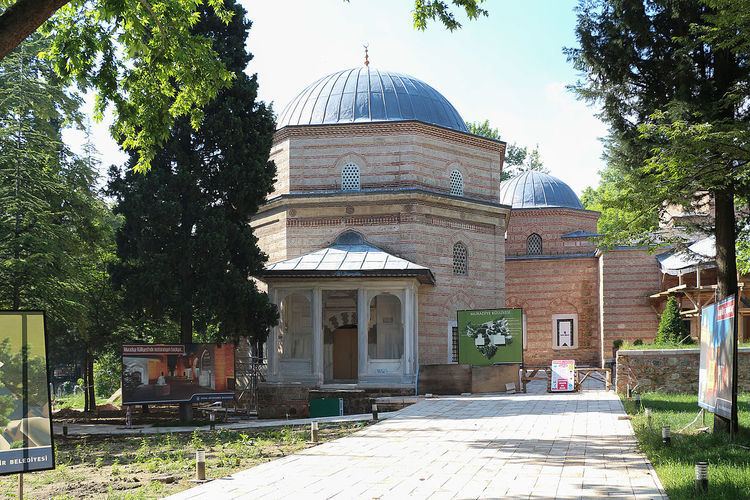Completed 1426 | Opened 1426 Number of minarets 2 | |
 | ||
Similar Green Mosque, Emir Sultan Mosque, Green Tomb, Koza Han, Grand Mosque of Bursa | ||
Bursa hisar the tombs of osman and orhan gazi muradiye complex turcja
The Muradiye Complex (Turkish: Muradiye Külliyesi) or the Complex of Sultan Murad II, the Ottoman sultan who ruled 1421-1451, is located in the city of Bursa in Turkey.
Contents
- Bursa hisar the tombs of osman and orhan gazi muradiye complex turcja
- ahzade mustafa muradiye k lliyesi muradiye complex bursa 2016
- History
- References
ahzade mustafa muradiye k lliyesi muradiye complex bursa 2016
History
Sultan Murat II was the last of the Ottoman sultans to reign in the original Ottoman capitol of Bursa, prior to the conquest of Constantinople in 1453. There are twelve tombs (türbe) in the complex, all belonging to relatives of this sultan. Construction of the complex began after the completion of the Yeşil Mosque, which is in the eastern area of Bursa. A large earthquake in 1855 damaged much of the Muradiye complex, and restorations have since been completed.
The large complex is composed of the Muradiye Mosque, Muradiye Madrasa, Muradiye Bath, Muradiye Hospice, a fountain, epitaphs, Sultan Murad II's tomb, Şehzade Ahmed's tomb, Cem Sultan's tomb, Şehzade Mahmud's tomb, Şehzade Mustafa's tomb, Mahidevran Sultan's tomb, Gülşah Sultan's tomb, Ebe Hatun’s tomb, Hüma Hatun's tomb, Sittişah Hatun's tomb, the Saraylilar's tomb, and Şirin Hatun's tomb.
The Mosque was the first project in the complex, completed in 1426. The mosque is built in a simplified inverse T plan with a domed portico in front, constructed of brick and with four major domes. Hexagonal tiles in turquoise and dark blue decorate the interior. There are two minarets, one that is old and one that is new due to collapse from the 19th century earthquake and was rebuilt in 1904. A fire damaged the mosque in the early 18th century, and so the mihrab was also rebuilt, in the rococo style.
The madrasa is located to the west of the mosque. It is composed of a central courtyard surrounded by student rooms and a classroom to the back, covered by a dome. The exterior is brick and stone. While the madrasa itself does not have a construction inscription due to numerous restorations, the inscription on the mosque says the madrasa was also constructed in 1426 by Murat II. Dark blue and turquoise tiles decorate the interior, while brick decorates the exterior entrance.
Sources conflict on the date of construction for the tomb of Murat II, either before his death in 1427 or after in 1451 commissioned by his son Mehmed II in accordance with his will. The building is constructed of brick and stone, in a square plan topped with a dome that is left open at the top. A vaulted gallery surrounds the dome, resting on Byzantine capitols. A large impressive wooden canopy over the entrance is carved in relief and embellished in star patterns. An annex contains four additional tombs, Alaaddin (whom the annex is named after, “Mausoleum of Alaaddin”), Şehzade Ahmet, Orhan and Şehzade Hatun.
The remaining eleven tombs belong to the rest of the sultan’s family to the south of the mosque and the madrasa. They are decorated with polychrome glazed tiles mostly in blue, except for the tombs of Şezade Mustafa and Mahidevran sultan which is decorated in painted Iznik tiles from the 16th century in the polychrome technique.
In the 1950s the madrasa became a tuberculosis clinic and it now houses a medical centre.
